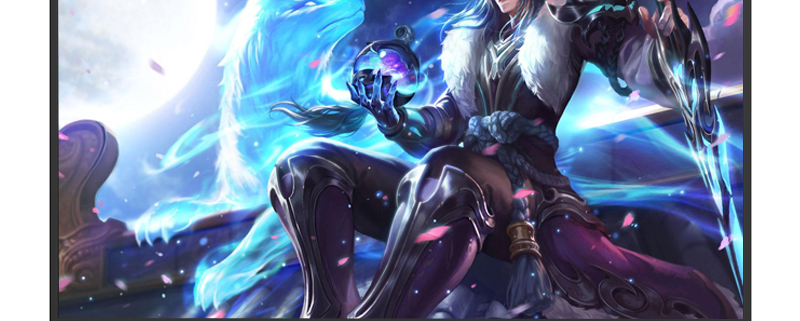The meaning of each parameter of the display(1)
1. Resolution
Resolution is also known as resolution and resolution. The liquid crystal display screen of a monitor is composed of individual pixels. Resolution is a representation of the number of vertical and horizontal pixels on the screen. For example, the resolution of your monitor is 1920×1080 , that is to say, this monitor has a total of 1920 pixels horizontally and a total of 1080 pixels vertically. The more pixels on the display screen, the more objects can be displayed at the same level of detail, or the same display object can be displayed more delicately, and under the same size display, the higher the resolution, the more accurate the display object can be. exquisite. The current mainstream display resolution is 1920×1080 (1080P), of course, 2560×1440 (2K), 3840×2160 (4K) can also be considered.
2. Size
The size of the display is actually the diagonal length of its display part, in inches (1 inch = 2.54cm). In the case of the same aspect ratio, the actual area is in a square ratio to the diagonal length. For monitors with different aspect ratios, such as 16:9 and ultra-wide 21:9 monitors, the size comparison does not directly reflect the size of the two screens. You only need to know that under the same “size”, the closer the screen is to a square, the actual display area will be larger. Just bigger.
In terms of display size, the mainstream size of desktop computer monitors is generally above 19 inches, and now the mainstream is 21.5, 22 inches, 23 inches, 23.6 inches, 27 inches or larger. Generally, 27 inches or more are recommended for 2K or 4K resolution.
3. Response time
The corresponding time marked by today’s monitors is the grayscale response time. The response time of the monitor is generally in milliseconds (ms), which refers to the response speed of the liquid crystal display to the input signal. The liquid crystal particles turn from dark to bright or from bright to dark. The response time is the two parts of “rising time” and “falling time”, and the response time usually mentioned refers to the sum of the two. The shorter the response time, the less smear phenomenon will appear on the instantaneously moving game screen, and the higher the precision of the screen definition will be.
For e-sports game players such as FPS, the response time is still very important. The length of the response time can affect whether the process of changing the display screen is clean and crisp, can prevent tailing, and improve the response speed and fluency of the dynamic screen. The response time of mainstream gaming monitors is between 1ms and 5ms, and the smaller the grayscale response time, the better.
4. Contrast
The improvement of the contrast makes the picture more layered, and the distinction between light and dark is obvious, which means that it is easier for users to see the picture under the dark conditions of the scene. Generally speaking, a contrast ratio of 200 can provide a good display effect, but some manufacturers pursue high contrast by blindly increasing the brightness. In fact, it does not help, and on the contrary, it reduces the service life. Some manufacturers claim that the dynamic contrast ratio , the effect in actual use is not very obvious. When working, the contrast ratio of the display is preferably between 60-80 values, and the brightness is preferably between 40-60 values. When playing games, it is recommended to adjust the brightness and contrast to between 80 and 100, so that the visual effect will be better.
5. HDR
Now there is a new standard for displays on the market: HDR, which can enhance the contrast of the picture, increase the color gamut and make the picture more visually impactful. HDR refers to the way of dynamically presenting contrast and color accuracy according to the situation of the scene. For example, in a black scene of a movie game player, the ordinary display is almost black, but some scenes in the dark can be seen on the display with HDR. Probably the so-called “bright black”. To realize HDR technology, the display must have relevant hardware design, which will affect the price performance.
6. Brightness
The unit of monitor screen brightness is cd/㎡, and usually the brightness reaches 250cd/㎡, which is enough for daily use. A high-brightness display may be clearer when displaying some dark scenes, but it will be too bright when displaying normal and bright scenes, which is more irritating to the eyes, and the eyes are more prone to fatigue after long-term use. The brightness of the LCD monitor should be adjusted to a minimum of 40 and a maximum of 80, so that the damage to the eyes is minimal. The higher the resolution of the display, the darker the brightness should be adjusted.
7. Color (color depth)
Each pixel of the display is composed of display units responsible for the three primary colors of RGB (red, green, blue), and their light and dark combinations form the color presented by this pixel. The number of colors used by the display is marked in bits, which is actually the number of light and dark changes that each display unit can display, and the unit of bit represents how many times 2, for example, 8bit color is 2 to the 8th power, each There are 256 changes in the display unit, and the color combination presented by a single pixel is 256×256×256=16 777 216, basically reaching the visual limit of ordinary people.
8. Color gamut
In layman’s terms, the color gamut of a display is how many colors it can display, which is mainly related to the accuracy of the control chip and display unit. The so-called “wide color gamut” display means that the display accuracy is very high, and it can show more The color has a wider coverage of the entire color range. At present, the common display color gamut standards are mainly sRGB and Adobe RGB, and there is also AppleRGB developed by Apple. sRGB is fully sufficient for general users, and is supported by most monitors and software, while Adobe RGB and AppleRGB appear more on professional monitors and professional software, and are aimed at professionals such as design and art.








